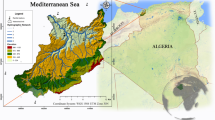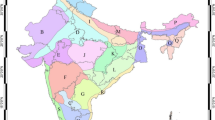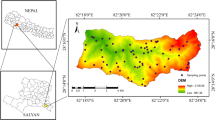Abstract
The quantitative estimate of soil erosion, in space and time, is valuable information to initiate land degradation measures at a watershed level. In this study, two models, Morgan Morgan Finney (MMF) and universal soil loss equation (USLE), were used in GIS environment to assess the soil erosion, as a function of land use/land cover, soil and topography in a mountainous watershed in the Kashmir Himalayan region, India. The two modelled soil erosion estimates were validated using the available land degradation maps of the area in order to determine their efficacy for soil erosion modelling. The results from the two models showed some similarity between the two soil erosion estimates. However, keeping in view the soil deposition being taken into consideration by MMF (47.33% of watershed area), the disagreement with the USLE soil estimates is understandable. USLE estimated 72.52% of watershed area under 0–1 kg m−2 year−1 while as the MMF model estimated only 41.27% of the watershed area in this category. In both the model results, almost equal area of the watershed has been classified with erosion > 10 kg m−2 year−1 category. Based on the model validation with the available land degradation data, the USLE estimates of soil erosion were found more reliable because of the good correlation with the land degradation maps. The erosion estimates worked out in this study, particularly the categories under very high, high, severe and very severe eroded areas, shall go a long way in framing up the strategies for mitigation and control of soil erosion in the mountainous Himalayan watershed.















Similar content being viewed by others
References
Adediji A, Tukur AM, Adepoju KA (2010) Assessment of revised universal soil loss equation (RUSLE) in Katsina area, Katsina state of Nigeria using remote sensing (RS) and geographic information system (GIS). Iran J Energy Environ 1(3):255–264
Aflizar RA, Masunaga T (2013) Assessment erosion 3D hazard with USLE and surfer tool: a case study of Sumani Watershed in West Sumatra Indonesia. J Trop Soils 18(1):81–92
Altaf S, Meraj G, Romshoo SA (2014) Morphometry and land cover based multi-criteria analysis for assessing the soil erosion susceptibility of the Western Himalayan watershed. Environ Monit Assess 186(12):8391–8412
Baba SMJ, Yusuf KW (2001) Modeling soil erosion in tropical environments using remote sensing and geographical informations systems. Hydrol Sci J 46(1):191–198
Badar B, Romshoo SA, Khan MA (2013) Modeling the catchment hydrological response in a Himalayan lake as a function of changing land system. Earth Syst Sci 112(2):434–450
Bai ZG, Dent DL, Olsson L, Schaepman ME (2008) Proxy global assessment of land degradation. Soil Use Manag 24(3):223–234
Behera P, Rao KD, Das KK (2005) Soil erosion modeling using MMF model-a remote sensing and GIS perspective. J Indian Soc Remote Sens 33(1):165–176
Bhattarai R, Dutta D (2007) Estimation of soil erosion and sediment yield using GIS at catchment scale. Water Resour Manag 21(10):1635–1647
Bhuyan SJ, Kalita PK, Jannsen KA, Barnes PL (2002) Soil loss predictions with three erosion simulation models. Environ Model Softw 17:135–144
Carré F, McBratney AB, Mayr T, Montanarella L (2007) Digital soil assessments: beyond DSM. Geoderma 142:69–79
Cassman KG (1999) Ecological intensification of cereal production systems: yield potential, soil quality, and precision agriculture. Proc Natl Acad Sci 96(11):5952–5959
Dabral PP, Baithuri N, Pandey A (2008) Soil erosion assessment in a hilly catchment of North Eastern India using USLE, GIS and remote sensing. Water Resour Manag 22:1783–1798
Dar RA, Romshoo SA, Chandra R, Ahmad I (2014) Tectono-geomorphic study of the Karewa Basin of Kashmir Valley. J Asian Earth Sci 92:143–156
De Vente J, Poesen J (2005) Predicting soil erosion and sediment yield at the basin scale: scale issues and semi-quantitative models. Earth Sci Rev 71(1–2):95–125
De Ploey J (1990) Modelling the erosional susceptibility of catchments in terms of energy. Catena 17:175–183
Dickinson A, Collins R (1998) Predicting erosion and sediment yield at the catchment scale. In: Vries PD, Agus F, Kerr J (eds) Soil erosion at multiple scales. principles and methods for assessing causes and impacts. CABI Publishing, Wallingford, pp 317–342
Erdogan EH, Erpul G, Bayramin İ (2007) Use of USLE/GIS methodology for predicting soil loss in a semiarid agricultural watershed. Environ Monit Assess 131(1–3):153–161
Fayaz MA, Balyan R, Sharma P (2018) Laboratory investigation for stabilization of clayey soil in Kashmir Valley. Int J Eng Dev Res 6(3):30–35
Fistikoglu O, Harmancioglu NB (2002) Integration of GIS with USLE in assessment of soil erosion. Water Resour Manag 16(6):447–467
Fu G, Chen S, McCool KD (2006) Modeling the impacts of no-till practice on soil erosion and sediment yield using RUSLE, SEDD and ArcView GIS. Soil Till Res 85:38–49
Griffin ML, Beasley DB, Fletcher JJ, Foster GR (1988) Estimating soil loss on topographically nonuniform field and farm units. J Soil Water Conserv 43:326–331
Gyssels G, Poesen J, Bochet E, Li Y (2005) Impact of plant roots on the resistance of soils to erosion by water: a review. Progr Phys Geogr 29(2):189–217
Iqbal MF, Khan IA (2014) Spatiotemporal land use land cover change analysis and erosion risk mapping of Azad Jammu and Kashmir, Pakistan. Egypt J Remote Sens Space Sci 17(2):209–229
Iqbal M, Sajjad H (2014) Watershed prioritization using morphometric and land use/land cover parameters of Dudhganga Catchment Kashmir Valley India using spatial technology. J Geophys Remote Sens 3:1–12
Iqbal M, Sajjad H, Bhat FA (2013) Morphometric analysis of Shaliganga sub catchment, Kashmir Valley, India using geographical information system. Int J Eng Trends Technol 4(1):10–14
ISRO (2018) Desertification and land degradation, Atlas of selected districts of india (based on IRS LISS III data of 2011-13 and 2003-05) volume 1. Indian space research organization, Space application Centre
Ives JD, Messerli B (1989) The Himalayan dilemma: reconciling development and conservation. Routledge, London
Jain MK, Kothyari UC (2000) Estimation of soil erosion and sediment yield using GIS. Hydrol Sci J 45(5):771–786
Jain SK, Kumar S, Varghese J (2001) Estimation of soil loss for a Himalayan watershed using GIS technique. Water Resour Manag 15:41–54
Jha MK, Paudel RC (2010) Erosion predictions by empirical models in a mountainous watershed in Nepal. J Spat Hydrol 10(1)
Karsli F, Atasoy M, Yalcin A, Reis S, Demir O, Gokceoglu C (2009) Effects of land-use changes on landslides in a landslide-prone area (Ardesen, Rize, NE Turkey). Environ Monit Assess 156(1–4):241
Khan S, Romshoo SA (2008) Integrated analysis of geomorphic, pedologic and remote sensing data for digital soil mapping. J Himal Ecol Sustain Dev 3:84–93. https://doi.org/10.15373/22778160/June2014/31
Kirmani NA, Sofi JA, Bhat MA, Bangroo SA, Bhat SA (2011) Soil micronutrient status of district Budgam. Res J Agric Sci 2(1):30–32
Kosmas C, Danalatos N, Cammeraat LH, Chabart M, Diamantopoulos J, Farand R, Mizara A (1997) The effect of land use on runoff and soil erosion rates under Mediterranean conditions. Catena 29(1):45–59
Kumar S, Kushwaha SPS (2013) Modelling soil erosion risk based on RUSLE-3D using GIS in a Shivalik sub-watershed. J Earth Syst Sci 122(2):389–398
Lee GS, Lee KH (2006) Scaling effect for estimating soil loss in the RUSLE model using remotely sensed geospatial data in Korea. Hydrol Earth Syst Sci Dis 3:135–157
Mati BM, Morgan RPC, Quinto JN (2006) Soil erosion modelling with EUROSEM at Emboriand Mukogodo catchments, Kenya. Earth Surf Process Landf 31:579–588
Meraj G, Romshoo SA, Ayoub S, Altaf S (2017) Geoinformatics based approach for estimating the sediment yield of the mountainous watersheds in Kashmir Himalaya, India. Geocarto Int. https://doi.org/10.1080/10106049.2017.1333536
Mitasova H, Hofierka J, Zlocha M, Iverson LR (1996) Modelling topographic potential for erosion and deposition using GIS. Int J Geogr Inf Syst 10(5):629–641
Mondal A, Khare D, Kundu S, Meena PK, Mishra PK, Shukla R (2014) Impact of climate change on future soil erosion in different slope, land use, and soil-type conditions in a part of the Narmada River Basin, India. J Hydrol Eng 20(6):C5014003
Mondal A, Khare D, Kundu S (2016) Impact assessment of climate change on future soil erosion and SOC loss. Nat Hazards 82(3):1515–1539
Moore ID, Burch GJ (1986) Physical basis of the length-slope factor in the universal soil loss equation 1. Soil Sci Soc Am J 50(5):1294–1298
Moore ID, Gessler PE, Nielsen GA, Peterson GA (1993) Soil attribute prediction using terrain analysis. Soil Sci Soc Am J 57:443–452
Morgan RPC (2009) Soil erosion and conservation. Wiley, New York
Morgan RPC, Duzant JH (2008) Modified MMF (Morgan–Morgan–Finney) model for evaluating effects of crops and vegetation cover on soil erosion. Earth Surf Process Landf 33(1):90–106
Morgan RP, Quinton JN (2001) Erosion modeling. In: Landscape erosion and evolution modeling. Springer, Boston, pp 117–143
Morgan RPC, Morgan DDV, Finney HJ (1984) A predictive model for the assessment of soil erosion risk. J Agric Eng Res 30:245–253
Nabi S (2016) Plant diversity in prevalent agroforestry systems of district Budgam. Doctoral dissertation, SKUAST Kashmir
Oliveira TS, Rodrigues PB, Sobrinho DAB, Panachuki TE, Wendland E (2013) Use of SRTM data to calculate the (R)USLE topographic factor. Acta Sci Technol 35(3):507–513
Pandey A, Chowdary VM, Mal BC (2007) Identification of critical erosion prone areas in the small agricultural watershed using USLE, GIS and remote sensing. Water Resour Manag 21:729–746
Pandey A, Mathur A, Mishra SK, Mal BC (2009) Soil erosion modeling of a Himalayan watershed using RS and GIS. Environ Earth Sci 59(2):399–410
Pandey A, Himanshu SK, Mishra SK, Singh VP (2016) Physically based soil erosion and sediment yield models revisited. Catena 147:595–620
Parveen R, Kumar U (2012) Integrated approach of universal soil loss equation (USLE) and geographical information system (GIS) for soil loss risk assessment in upper south Koel Basin, Jharkhand. J Geogr Inf Syst 4(6):588–596
Pham TG, Degener J, Kappas M (2018) Integrated universal soil loss equation (USLE) and geographical information system (GIS) for soil erosion estimation in A Sap basin: Central Vietnam. Int Soil Water Conserv Res 6(2):99–110
Phillips JD (1990) Relative importance of factors influencing fluvial soil loss at theglobal scale. Am J Sci 290:547–568
Prasannakumar V, Vijith H, Abinod S, Geetha N (2012) Estimation of soil erosion risk within a small mountainous sub-watershed in Kerala, India, using revised universal soil loss equation (RUSLE) and geo-information technology. Geosci Front 3(2):209–215
Rao YP (1981) Evaluation of cropping management factor in universal soil loss equation under natural rainfall condition of Kharagpur, India. In: Proceedings of Southeast Asian regional symposium on problems of soil erosion and sedimentation. Asian Institute of Technology, Bangkok, pp 241–254
Rashid M, Lone MA, Romshoo SA (2011) Geospatial tools for assessing land degradation in Budgam district, Kashmir Himalaya, India. J Earth Syst Sci 120(3):423
Raza M, Ahmad A, Mohammad A (1978) The valley of Kashmir: a geographical interpretation, vol 1, The land. Vikas Publishing House Private, New Delhi, pp 115–123
Renschler C, Diekkruger B, Mannaerts C (1997) Regionalization in surface runoff and soil erosion risk evaluation. In: Regionalization of hydrology, vol 254. IAHS Publishers, Wallingford, pp 233–241
Renschler CS, Mannaerts C, Diekkrüger B (1999) Evaluating spatial and temporal variability in soil erosion risk—rainfall erosivity and soil loss ratios in Andalusia, Spain. Catena 34:209225
Romshoo SA, Bhat SA, Rashid I (2012) Geoinformatics for assessing the geomorphological control on the hydrological response at watershed scale in Upper Indus basin. Earth Syst Sci 121(3):659–686
Romshoo SA, Amin M, Ahmad I, Sastry KLN (2016) Soil erosion estimation of Lidder watershed, Kashmir Himalaya using Morgan-Morgan-Finney model in GIS environment. J Himal Ecol Sustain Dev 11(2016):3–20
Romshoo SA, Altaf S, Amin M, Ameen U (2017) Sediment yield estimation for developing soil conservation strategies in GIS environment for the mountainous Marusudar catchment, Chenab basin, J&K, India. J Himal Ecol Sustain Dev 12:16–32 (ISSN No. 0973–7502)
Roose E (1975) Erosion et ruissellement en Afrique de l’ouest: vingt années de mesures en petites parcelles experimentales
Shabani F, Kumar L, Esmaeili A (2014) Improvement to the prediction of the USLE K factor. J Geomorphol 201(1):229–234
Shah AH, Ahmad HF, Nengroo ZA, Kuchay NA, Bhat MS (2013) Changing land use and cropping pattern in Budgam District of Jammu and Kashmir—a spatio-temporal analysis. Int J Sci Eng Res 4(2):120–142
Shiono T, Kamimura K, Okushima S, Fukumoto M (2002) Soil loss estimation on a local scale for soil conservation planning. Jpn Agric Res Q 36(3):157–161
Shrestha DP, Jetten VG (2018) Modelling erosion on a daily basis, an adaptation of the MMF approach. Int J Appl Earth Obs Geoinf 64:117–131
Shruthi RBV, Kerle N, Jetten V, Abdellah L, Machmach I (2015) Quantifying temporal changes in gully erosion areas with object-oriented analysis. Catena 128:262–277
Singh G, babu R, Narain P, Bhusan LS, Abrol IP (1992) Soil Erosion rates in India. J Soil Water Conserv 47(1):97–99
USDA (1972) National engineering handbook, section 4, hydrology. USDA, Soil Conservation Service. US Government Printing Office, Washington, DC
Wagenbrenner JW, MacDonald LH, Rough D (2006) Effectiveness of three post-fire rehabilitation treatments in the Colorado front range. Hydrol Process 20(14):2989–3006
Williams JR, Berndt HD (1972) Sediment yield computed with universal equation. J Hydrol Div ASCE 98(12):2087–2098
Wischmeier WH, Smith DD (1978) Predicting rainfall erosion losses. USDA agricultural research services handbook 537. USDA, Washington, DC
Wolkerstorfer G, Strauss P (2004) Soil erosion at the mesoscale: comparison of two erosion models for a pre-alpine Austrian basin. IAHS Publ 288:339–344
Zaz SN, Romshoo SA (2012) Assessing the geoindicators of land degradation in the Kashmir Himalayan region, India. Nat Hazards 64(2):1219–1245
Acknowledgements
The research work was conducted as part of the Ministry of Environment, Forests and Climate Change and Space Application Centre (SAC), Indian Space Research organization (ISRO) Government of India sponsored national research project titled “Desertification and Land Degradation: Monitoring, Vulnerability Assessment and Combating Plans”. The financial assistance received from the sponsors under the project to accomplish this research is thankfully acknowledged. The authors express gratitude to the anonymous reviewers for their valuable comments and suggestions on the earlier version of the manuscript that greatly improved its content and structure.
Author information
Authors and Affiliations
Corresponding author
Rights and permissions
About this article
Cite this article
Amin, M., Romshoo, S.A. Comparative assessment of soil erosion modelling approaches in a Himalayan watershed. Model. Earth Syst. Environ. 5, 175–192 (2019). https://doi.org/10.1007/s40808-018-0526-x
Received:
Accepted:
Published:
Issue Date:
DOI: https://doi.org/10.1007/s40808-018-0526-x




